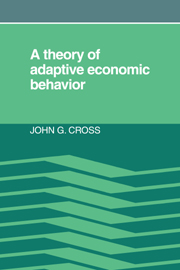Book contents
- Frontmatter
- Contents
- Preface
- 1 Introduction
- 2 Models of convergence
- 3 Behavior in the short run
- 4 Uncertainty
- 5 An application to state lottery games
- 6 An application to the problem of search behavior
- 7 Inflationary disequilibrium
- 8 Advertising and imitation
- 9 An application to migration
- 10 Conclusions
- References
- Index
2 - Models of convergence
Published online by Cambridge University Press: 07 October 2011
- Frontmatter
- Contents
- Preface
- 1 Introduction
- 2 Models of convergence
- 3 Behavior in the short run
- 4 Uncertainty
- 5 An application to state lottery games
- 6 An application to the problem of search behavior
- 7 Inflationary disequilibrium
- 8 Advertising and imitation
- 9 An application to migration
- 10 Conclusions
- References
- Index
Summary
The model we shall employ was developed originally from a psychological learning paradigm, although its formal structure can be applied equally well to almost any behavioral feedback process if the variables are suitably interpreted. There is only one condition that is absolutely essential to any application of the model, and that is that the dependent behavioral variable be defined as a probability or a probability vector rather than as a definite action. Indeed, it is because statistical distributions so often provide the best empirical descriptions of behavior that the use of feedback models has become widespread. In the case of biological and sociobiological theory, probability models are standard fare: Genetic models all describe random-draw processes that focus on the likelihood that an individual will have certain physical or behavioral traits, given the gene frequencies that characterize the population of that individual's own ancestors. Psychological models also conventionally use probabilities as dependent variables, a use that has evolved from long experience with laboratory evidence indicating that even under carefully controlled circumstances one cannot predict voluntary choice behavior with certainty. This may, of course, be a reflection only of our own limited understanding of human nature. Some might argue that every choice does have a deterministic foundation and that our failure to make perfect predictions is a reflection of our ignorance of the essential exogenous variables rather than the result of any fundamental randomness in the behavior under study.
- Type
- Chapter
- Information
- A Theory of Adaptive Economic Behavior , pp. 15 - 40Publisher: Cambridge University PressPrint publication year: 1983



